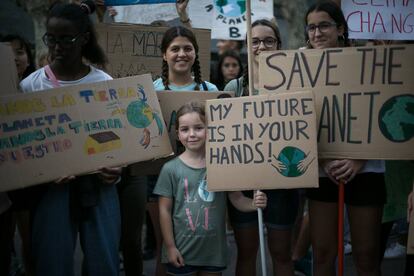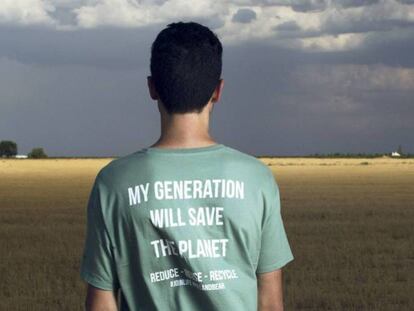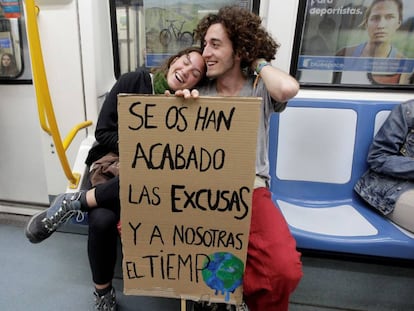The great transformation: the Green New Deal for Spain
Jeremy Rifkin, a political advisor to the EU and China, explores why the fossil fuel civilization will collapse by 2028, and the bold economic plan to save life on Earth

Our scientists tell us that human-induced climate change brought on by the burning of fossil fuels has taken the human race and our fellow species into the sixth mass extinction event of life on Earth. The United Nations Intergovernmental Panel on Climate Change (IPCC) estimates that human activity has caused the temperature to rise 1°C (Celsius) above pre-industrial levels and predicts that if it crosses a threshold beyond 1.5°C, it will unleash runaway feedback loops and a cascade of climate-change events that would decimate the Earth’s ecosystems.
In a 2018 report, the IPCC concluded that to avoid the environmental abyss we would have to cut the emission of global warming gases 45% from 2010 levels – and we only have 12 years left to make this happen. This will require a transformation of our global economy, our society, and our very way of life without precedent in human history. In other words, the human race faces a razor-thin timeline for a radical reorientation of civilization.
The human race faces a razor-thin timeline for a radical reorientation of civilization
Facing a global climate emergency, a younger generation of millennials and Gen Zs is spearheading an unprecedented planetary mobilization in support of a global Green New Deal to save life on Earth, and setting the agenda for a bold political movement with the potential to revolutionize society.
In the United States, all of the major Democratic Party candidates for the 2020 presidential elections have announced their support of a Green New Deal, as has the United States Conference of Mayors. In the European Union, Ursula von der Leyen, the president-elect of the European Commission, has likewise made the Green New Deal the centerpiece of Europe’s transformation into a zero-emission, post-carbon society.
While the Green New Deal has become a lightning rod in the political sphere, there is a parallel movement emerging within the business community that will shake the very foundation of the global economy in coming years. Key sectors of the economy – information and communication technologies, power and electricity, transportation and logistics, and real estate – are fast decoupling from fossil fuels in favor of ever cheaper solar and wind energies and the accompanying clean technologies, green business practices, and processes of circularity and resilience that are the central features of an ecological society.

The levelized costs of utility-scale solar and wind installations have plummeted and are now below the cost of nuclear power, oil, coal, and natural gas, leaving the old conventional energies and accompanying technologies behind. New studies are sounding the alarm that trillions of dollars in stranded fossil fuel assets could create a carbon bubble likely to burst by 2028, causing the collapse of the fossil fuel civilization. “Stranded assets” are all the fossil fuels that will remain in the ground because of falling demand as well as the abandonment of pipelines, ocean platforms, storage facilities, energy generation plants, backup power plants, petrochemical processing facilities, gasoline stations, auto service centers, and the myriad industries tightly coupled to the fossil fuel culture.
Fossil fuel-dependent countries like Spain will be caught in the crosshairs between the plummeting price of solar and wind and the fallout from peak oil demand and accumulating stranded assets in the oil industry. The marketplace is speaking, and governments everywhere will need to quickly adapt if they are to survive and prosper.
It is clear that Spain and the world need a new economic vision that is compelling and executable by big cities, small towns, and rural communities if we are to make the transition from a dying fossil fuel civilization to an emerging green civilization. We need to step back, then, and ask the question “how do the great economic paradigm shifts in history occur?”
In the United States, all of the major Democratic Party candidates for the 2020 presidential elections have announced their support of a Green New Deal
Every major economic transformation has required three elements, each of which interacts with the others to enable the system to operate as a whole: a new communication medium, a new power source, and a new transportation mechanism to manage, power, and move economic activity, social life, and governance. In the 19th century, steam-powered printing and the telegraph, abundant coal, and locomotives on national rail systems meshed in a common infrastructure to manage, power, and move society, giving rise to the First Industrial Revolution. In the 20th century, centralized electricity, the telephone, radio and television, cheap oil, and internal combustion vehicles on national road systems converged to create an infrastructure for the Second Industrial Revolution to manage, power, and move society.
We are now on the cusp of a Third Industrial Revolution. The digitized broadband communication internet is converging with a digitized renewable energy internet, powered by solar and wind electricity, and a digitized mobility and logistics internet of autonomous electric and fuel-cell vehicles, powered by green energy, atop an internet of things (IoT) platform, embedded in a zero-emission commercial, residential, and industrial building stock to manage, power, and move society in the 21st century.
Buildings – residential, commercial, industrial, and institutional – are being retrofitted and transformed into resilient, zero-carbon, energy-efficient smart nodes and networks embedded in an IoT matrix. Building nodes, connected to the IoT infrastructure, will act as distributed edge data centers, green micro power-generating plants, energy storage sites, and transportation and logistics hubs to manage, power, and move economic activity and social life in a smart green Spain. Buildings will no longer be passive, walled-off private spaces but, rather, actively engaged semi-public entities sharing their renewable energies, energy efficiencies, energy storage, electric mobility, and a wide range of other economic activity with one another on The Commons and at the discretion of their occupants.
The new smart sustainable infrastructure will involve every sector and industry
The scale-up of the new smart sustainable infrastructure will involve every sector and industry and make possible the new business models and mass employment opportunities that characterize the shift to a green economy. New studies show that the shift to a Third Industrial Revolution infrastructure and the new business practices that plug into it will result in a giant leap in “aggregate efficiency” while ushering in a zero-carbon, ecologically sustainable and highly resilient circular economy.
The digital economy also raises risks and challenges, not the least of which is guaranteeing network neutrality to ensure everyone has equal access to the networks, protecting privacy, ensuring data security, and thwarting cybercrime and cyberterrorism. How do we prevent nation-states from hacking into other countries’ social media and spreading misinformation to influence the outcome of their elections? How do we push back against giant internet companies becoming monopolies and commodifying our personal online data for sale to third parties for commercial uses? The dark side of the internet will require vigilant regulatory oversight at the local and state levels.
The construction of a national smart grid – the Energy Internet – across Spain will serve as the backbone of the Green New Deal transformation. The electricity grid is moving from a fossil fuel-based centralized system to a distributed electricity system based on potentially millions of solar- and wind-generation sites feeding in and off a smart, digitized, high-voltage nationwide power grid. In the new system, every business, neighborhood, and homeowner becomes a potential producer of electricity, sharing their surplus with others on a smart energy internet that is beginning to stretch across national and continental landmasses. The national government should take the primary responsibility for financing the ten to twenty-year build-out of the national power grid – the energy internet – with Spain’s regions financing the remainder.
Every major economic transformation has required three elements
The smart national power grid, providing seamless digital interconnectivity to enable the sharing of electricity from renewable energy sources across every region of the country, is analogous to the build-out of the American Interstate Highway System, which provided a seamless interconnectivity for mobility across the country in the 20th century. When Dwight Eisenhower became president in 1953, he had in mind a “grand plan” for an interstate highway system connecting all of the American economy and society to provide the streamlined mobility infrastructure for the post-WWII economic boom. Spain and countries around the world followed. Like the interstate highway system, the emerging national energy internet will digitally connect businesses, homeowners, civil society and government services across Spain, dramatically increase the nation’s aggregate efficiency, reduce the country’s carbon footprint to near-zero, and usher in a more sustainable and resilient high performance economy.
There is another parallel between the Third Industrial Revolution’s national renewable energy internet and the interstate highway system. In the 1950s, the existential threat was a potential nuclear attack. President Eisenhower argued that the interstate highway system would speed mass evacuations from the cities in the event of a catastrophic nuclear war. Today, the threat is cyber-war and climate disasters.
On the upside, a smart Spanish national power grid will manage an ever more diverse and complex energy infrastructure made up of literally millions of players in dense relationships on ever-shifting platforms. Yet the very complexity of the current system makes it increasingly vulnerable to cyberattacks and climate events. The key to cyber-security and climate adaptation rests in deepening resiliency and, that, in turn, requires an expansion of distributed power in every community. The installation of microgrids will be Spain’s frontline insurance. Were a cyberattack or climate disaster to happen anywhere in the country, crippling the smart national power grid, homeowners, businesses, and entire communities would be able to quickly go off-grid, reaggregate, and share electricity neighborhood to neighborhood, which would allow society to continue functioning.
The thing to bear in mind is that the collapse of fossil fuel civilization is inevitable, despite any efforts by the fossil fuel industries to forestall it
In addition to overseeing the build-out of the smart national power grid, the national government will also have to take responsibility for establishing the codes, regulations and standards that will need to be legislated to speed the transition into an integrated green zero-emission Third Industrial Revolution infrastructure across the regions and aligned throughout the country.
The Spanish government will need to rely on a national green bank system that can provide funds to regional and municipal green banks that, in turn, can leverage those funds in securing sufficient financing via the issuing of green bonds to invest in scaled green Third Industrial Revolution infrastructure build-outs. The national government will also provide a wide range of generous incentives (“carrots”) and mandates (“sticks”) to help regions and municipalities expedite the financing of the infrastructure transformation.
While some of the financing of the infrastructure will come from tax revenue and the re-prioritization of government budgets, much of the investments in green bonds will come from institutional funds, and, particularly, public and private pension funds – the largest pool of capital in the world as of 2018, worth over $40 trillion. Karl Marx would never have envisioned a 21st-century reality where the workers of the world are the primary owners of global investment capital via their public and private pension funds. Worried over climate change and the prospect of their funds remaining in a fossil fuel industry beset by stranded assets, which could wipe out the retirement funds of millions of workers, pension funds are beginning to divest their funds from the fossil fuel sector and related industries that service and/or depend on it, like the petrochemical industry, and reinvesting in the green opportunities that constitute the smart Third Industrial Revolution economy.
The thing to bear in mind is that the collapse of fossil fuel civilization is inevitable, despite any efforts by the fossil fuel industries to forestall it. Market forces are far more powerful than whatever lobbying maneuvers the fossil fuel industry might entertain. As mentioned, solar and wind energies are now the cheapest energies in the world, and their fixed costs will continue to plunge on an exponential curve far into the future, and the marginal cost of generating solar and wind energy is nearly zero. Unlike the extraction and refining costs of coal, oil, gas, and uranium, the sun and wind are free.
But the “invisible hand” alone will not steer us into the Age of Resilience. Building a new ecological civilization from the ashes of a collapsed fossil fuel civilization will require a far more collective response that brings together government, industry, and civil society in every municipality and region with the appropriate mix of public capital, market capital, and social capital to quickly scale up a smart, community-wide, Green New Deal, zero-emission Third Industrial Revolution infrastructure that can take humanity into a sustainable era.
Jeremy Rifkin is the author of The Green New Deal: Why the Fossil Fuel Civilization Will Collapse by 2028, and the Bold Economic Plan to Save Life on Earth. Rifkin is an advisor to the European Union, the People’s Republic of China, and heads of state around the world. Part II of this analysis will be published soon.









































